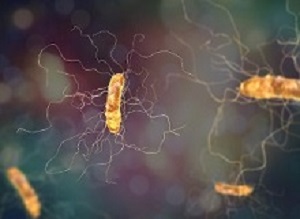 Research has shown how surgical gowns used in hospitals are retaining superbug Clostridium difficile (C difficile), even after being treated with the recommended amount of disinfectant. The research, led by the University of Plymouth, tested single-use hospital surgical gowns (made of polypropylene) that had been infected with three different strains of C difficile, a bacteria that can cause severe diarrhoea, bowel complications and even death.
Research has shown how surgical gowns used in hospitals are retaining superbug Clostridium difficile (C difficile), even after being treated with the recommended amount of disinfectant. The research, led by the University of Plymouth, tested single-use hospital surgical gowns (made of polypropylene) that had been infected with three different strains of C difficile, a bacteria that can cause severe diarrhoea, bowel complications and even death.
After treating infected items for ten minutes with disinfectant containing 1,000 parts per million of chlorine – the amount and time recommended by the UK’s Department of Health and Social Care – the team found that all strains of C difficile spores still survived on the gowns and did not reduce, allowing them to potentially transfer to other items.
The work was published with collaboration from Cardiff University, and supported by the Society for Applied Microbiology.
The research took place because the gowns were suspected to be contributing to C difficile transmission in a US hospital. Contaminated gowns from the US hospital were tested for presence of C difficile and a deadly 027 type strain was isolated, showing that the gowns can pick up and retain the spores.
In this study, new gowns had the bacteria ‘spiked’ onto them for testing purposes. Three strains of C difficile were tested including R20291, which caused severe outbreaks in UK hospitals between 2003 and 2006. This strain is known to cause mortality in patients as it is becoming resistant to the main antibiotic treatments, vancomycin and metronidazole.
To examine the ability of C difficile to adhere to, and subsequently transfer from, hospital surgical gowns, spores were applied directly to the surgical gowns in water for 10 seconds, 30 seconds, 1 minute, 5 minutes and 10 minutes before being removed and discarded. This was designed to mimic transfer of infectious bodily fluids in the clinical setting and assess the potential for onward transmission to patients.
There was no significant difference between the amount of spores recovered from the gowns and the contact time of the spores to the gowns; suggesting that the spore transfer between surfaces occurred within the first 10 seconds of contact. The items were then treated with 1,000 ppm chlorine-releasing disinfectant, sodium dichloroisocyanurate (NaDCC) to try and tackle the bug.
Principal investigator and study lead Dr Tina Joshi, part of the Institute of Translational and Stratified Medicine (ITSMed) at the University of Plymouth, explains that this work can be applied to hospitals anywhere in the world, and should help inform future guidelines on infection control and biocides (bacteria killers). She said: “C difficile is a really nasty superbug and it’s so important that hospitals stop it from spreading. This study shows that even when we think an item has been suitably cleaned, it hasn’t been necessarily – 1,000 parts per million of chlorine just isn’t enough as the bacteria survived and grew after disinfection.
"As well as possibly upping the concentration of the biocide, the research highlights the need for appropriate hygiene practices. Gowns should not be worn outside of isolated areas as our work has shown that C difficile spores are good at sticking to clinical surfaces, and can so easily be transferred, causing infections in patients. In an age where infections are becoming resistant to antibiotics, it’s worrying to think that other bacteria are becoming resistant to biocides. So the best thing we can do is ensure that infection control procedures are robust and standardised.”
Joshi is currently in Chile to further investigate the mechanisms behind the biocide resistance.
In addition, she works on antimicrobial resistance, and is currently developing a new point-of-care test to detect antimicrobial resistant (AMR) genes in pathogens, all within the time frame of a doctor’s appointment.
Abstract
Clostridium difficile is the primary cause of antibiotic-associated diarrhea globally. In unfavourable environments the organism produces highly resistant spores which can survive microbicidal insult. Our previous research determined the ability of C. difficile spores to adhere to clinical surfaces; finding that spores had marked different hydrophobic properties and adherence ability. Investigation into the effect of the microbicide sodium dichloroisocyanurate on C. difficile spore transmission revealed that sub-lethal concentrations increased spore adherence without reducing viability. The present study examined the ability of spores to transmit across clinical surfaces and their response to an in-use disinfection concentration of 1,000-ppm of chlorine-releasing agent sodium dichloroisocyanurate. In an effort to understand if these surfaces contribute to nosocomial spore transmission, surgical isolation gowns, hospital-grade stainless steel and floor vinyl were spiked with 1 × 106 spores/ml of two types of C. difficile spore preparations: crude spores and purified spores. The hydrophobicity of each spore type versus clinical surface was examined via plate transfer assay and scanning electron microscopy. The experiment was repeated and spiked clinical surfaces were exposed to 1,000-ppm sodium dichloroisocyanurate at the recommended 10-min contact time. Results revealed that the hydrophobicity and structure of clinical surfaces can influence spore transmission and that outer spore surface structures may play a part in spore adhesion. Spores remained viable on clinical surfaces after microbicide exposure at the recommended disinfection concentration demonstrating ineffectual sporicidal action. This study showed that C. difficile spores can transmit and survive between varying clinical surfaces despite appropriate use of microbicides.
Authors
Calie Dyer, Lee P Hutt, Robert Burky, Lovleen Tina Joshi
[link url="https://www.plymouth.ac.uk/news/hospital-gowns-retain-superbugs-even-after-disinfectant-use-research-shows"]University of Plymouth material[/link]
[link url="https://aem.asm.org/content/early/2019/06/24/AEM.01090-19"]Applied and Environmental Microbiology abstract[/link]
